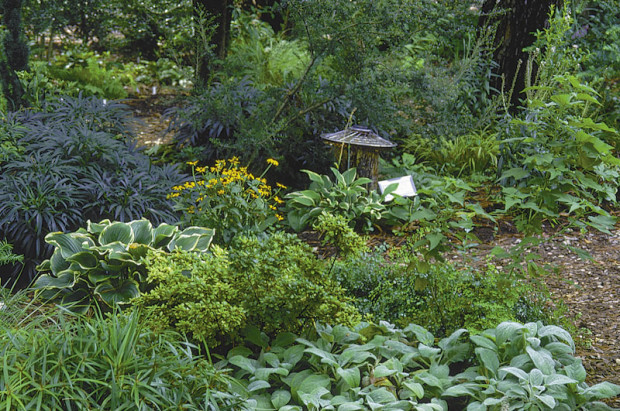
How to prepare shady beds under trees and select choice shade plants
By Janet Macunovich / Photographs by Steven Nikkila
Dark thoughts haunt me at high summer. As I tend sun-soaked beds, sweat-soaked myself, I find it hard to concentrate on what I’m doing. My mind wanders to shady corners and wooded lots, dappled clearings and deep, quiet, ferny retreats. It’s all I can do to keep my feet from following suit.
From the sunny side, all shade is mysterious. The details of the spot become clear only when you step within the dark. Drawn to a dark corner by the prospect of a cool retreat, I am sometimes disappointed to find shade but little refreshment. Barren ground can do that—hard-packed, lifeless soil can’t provide visual and mental refreshment to accompany the cooler air.
If you have a shaded spot that doesn’t measure up as a garden retreat, chances are that you can change the situation in three steps.
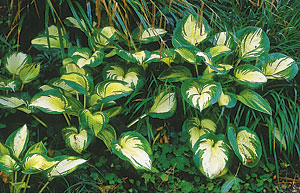

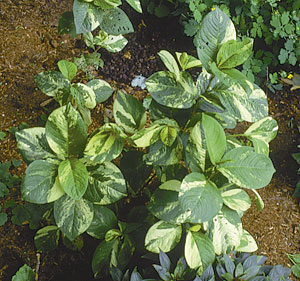
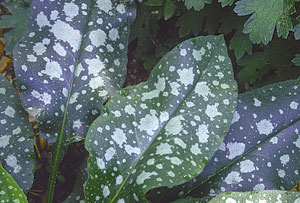
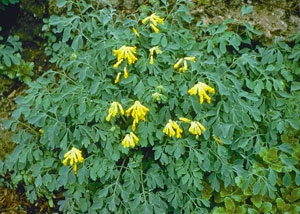
First, beef up the soil. Plants that grow under and around trees in nature do so in decades or centuries of fallen leaf litter. High in humus, it’s moisture retentive and returns to the soil almost all of what was removed to produce those leaves. Soil animals—worms, insects, and microscopic creatures—teem in the rich leaf mold, adding nitrogen and changing leaves into easily-absorbed nutrients.
Our overly-tidy ways lead us to remove fallen leaves and twigs. As a consequence, we create wastelands under trees. The first thing every really successful shade gardener does is add lots of compost—not soil, but compost with its higher organic matter content—and keep adding it every year. This means letting fallen leaves lie, or shredding them and putting them back down. At an older home with older trees, the soil may have been starved for decades, so I often start a new shade garden with a 6- to 8-inch depth of compost. Every year as the plants die back in the fall, I add 1 to 2 inches more. Just don’t stack this topdressing against the tree trunks and the trees will love it too.
Next, throw out your old concept of watering. To grow great plants in the shade you must water the trees first and then the garden. Since a large tree can consume a thousand gallons of water on a hot, breezy summer day, watering a shade garden can mean providing 3, 4, or 5 times as much water as you might in a sunny garden. Soaker hoses woven through the beds might have to run for 4 or 5 hours every second or third day to keep the gardens growing.
Finally, pick plants that love the shade. Stay away from “shade tolerant” plants, which are often lackluster, few-flowered and floppy in the shade. Here are some of my favorite perennials for shade. I group them by the design characteristics that are most important to shade—note that “flower” is not one of these. Blooms are more of a bonus in the shade than anything else. All of the plants on my list do bloom, but none of them has the stunning display of a daisy or a delphinium. Instead, they offer height, texture or foliage color.
For height:
Bugbanes (Cimicifuga species), or under the less-common name I prefer to use, fairy candles. Ferny foliage much like an astilbe, with tall wands of white flowers in June (C. racemosa), July or August (C. ramosa), or September (C. simplex). C. racemosa is tallest, at six feet. C. ramosa is 3 to 4 feet tall, and C. simplex usually between 2 and 3 feet. Varieties of C. ramosa with bronze or purple foliage are available. One of the glories of bugbanes is how sturdy and straight they stand in the shade, but be forewarned, if the light is very strong from one side and the shade very deep on the other, they will lean and may require staking.
Meadow rue, woodsy members of the genus Thalictrum. With their columbine-like foliage, they can be mistaken for this lesser plant in early spring, but not once they begin to tower. T. flavum subsp. glaucum is a personal favorite, 5 to 6 feet tall with ghostly blue green foliage and yellow green flowers in June. T. rochebruneanum puts on a show like a 5- to 6-foot mauve baby’s breath in July. Thalictrums often need staking in the shade. Be sure to stake them before they begin to fall, to make the work easier on you, easier on the plant, and more visually pleasing. Although this can be a tedious process, since each main stem will need its own stake, it’s worth it.
Goatsbeard (Aruncus dioicus). A true aristocrat. Straight, sturdy and reliably showy in June even in the deepest shade—it’s often mistaken for a five-foot shrub with white astilbe flowers. When grown in deep shade, it takes many years of growth for a plant to accumulate the energy to match the stature of its one-year-old sun-grown brethren. To get around this reality, I often grow the goatsbeard in sun for a year to give it some size, then move it into the shade.
Turtlehead (Chelone obliqua, C. lyonii). Three to four feet, straight stems topped with spikes of pink or white flowers in August. An individual floret on the spike of this snapdragon relative resembles a turtle’s head.
Japanese anemone (Anemone x hybrida). Not for everyone, this 3- to 4-foot plant is usually quite the spreader where it’s happy, and quick to disappear where it’s not. September-blooming (it blooms a month earlier in sunnier locations) flowers are white, pink or mauve, resemble single peonies, and varieties with double flowers are available.
For coarse texture to offset the fine foliage of astilbes, ferns, etc.
Hosta. Of course. Enough said!
Rodgers flower (Rodgersia species). Huge compound leaves may be as big around as a child’s saucer sled. Creamy white flowers cluster in spikes or one-sided clusters on stalks that rise to 3 or 4 feet in June. Grows best where it’s moist, maybe even too moist for other plants.
Variegated brunnera (Brunnera macrophylla varieties). Heart-shaped leaves 9 inches across. Blue forget-me-not flowers on 18 inch stems in May.
Variegated lungwort or Bethlehem sage (Pulmonaria varieties). Leaves streaked, edged or spotted with silver or white form 12-inch mounds. Blue, pink or white flowers on 18-inch stems in April-May.
Edging and filler
Golden bleeding heart (Corydalis lutea). Twelve-inch mounds of lacy, blue green leaves with butter yellow flowers from Memorial Day into July. Spreads readily by seed where it’s happy.
Dwarf goatsbeard (Aruncus aethusifolius). Like a tiny astilbe, with creamy white spikelets in May and June.
Tellima (Tellima grandiflora). A mound of slightly furry foliage reminiscent of coral bells. Much more reliable, longer-lived and fuller blooming in shade than a coral bell, though. Flowers are green-white to barely pink on 18-inch stems, in May-June.
Chinese astilbe (Astilbe chinensis). August blooming, and spreading by runners where conditions are good. 18 inches.
For foliage color
Tovara (may be listed as T. virginiana, Persicaria virginiana, or Polygonum virginiana ‘Painter’s Palette’). Long, pointed-oval leaves splashed with white and pink really add spark to shady corners. 18 inches. Flower is white, but not significant.
Golden satin grass (Hakonechloa macra ‘Aureola’). A 15-inch fountain of gold-edged leaves; not really a grass, but who cares!
Hosta. Again, enough said!
Variegated Solomon’s seal (Polygonatum odoratum ‘Variegatum’). Arching stems 18 inches tall, each leaf outlined in white. White bells dangle from the stems in April-May.
Japanese painted fern (Athyrium niponicum var. ‘Pictum’). Silver and maroon marked foliage. Buy it for the color you see, because the variety is quite variable—the plant you buy that is more green than silver won’t become silver later. Loves the drier areas of a garden, once established.
Janet Macunovich is a professional gardener and author of the books “Designing Your Gardens and Landscape” and “Caring for Perennials.” Read more from Janet on her website www.gardenatoz.com.

Sharon Liedel says
Janet,
Thank you for your columns and insight into gardening. I have read your articles for years in the Detroit Free Press, the Michigan gardener and any place else I find them. I love gardening and have learned so much from you. Thank you.
Dorothy Hastings says
for Janet Macunovich. I love your articles and will check out your website, too. However, your review of shade plants had a significant omission. You failed to mention that meadow rue can cause an itchy, painful rash in some people. The effect is nearly instantaneous so it wasn’t hard for me to decipher what caused my rash. Poison ivy is the only other plant I react to and I don’t have seasonal allergies so I believe there must be a sizable number who can’t touch this plant. Persons thinking of buying rue should run their bare forearms over the leaves. By the time they reach check-out, they will know whether they can handle this plant.